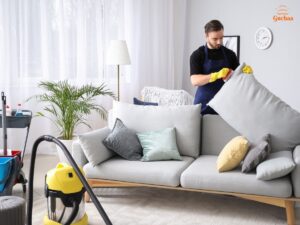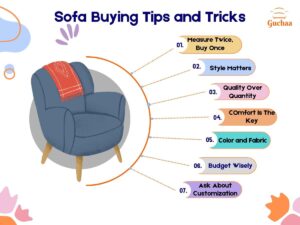
The Ultimate Furniture Buying Guide
Buying a new furniture for your living space is an exciting process. It transforms the look of your

Your sofa is not just a piece of furniture. It’s a central junction of comfort and relaxation in your home. However, daily use accumulates dirt, stains, and spills. So, your sofa needs proper cleaning. Cleaning your sofa may seem simple. But it must be delicate to ensure it stays pristine. We’ve busy schedules these days. So, you need to explore different sofa buying tips and tricks to help you find the ideal sofa that matches your needs and preferences. After buying the right sofa, maintenace is mandatory. We’ve listed the dos and don’ts for sofa cleaning and maintenance. It helps you achieve a spotless sofa finish. Check out below:
Read and follow the manufacturer’s instructions carefully. It must be done before initiating any cleaning process. Each sofa is unique. So, manufacturers provide specific guidelines for cleaning and maintenance. Following these instructions carefully very is essential. It prevents potential damage to the fabric. In some cases, it helps to be safe from voiding warranties. So, manufacturers offer valuable insights to use suitable cleaning agents. They also recommend techniques and precautions. It ensures the longevity and appearance of your sofa.
Regular vacuuming on your sofa is very essential. It helps to keep your sofa clean and healthy. Over time, dust, crumbs, and pet hair can accumulate on the sofa surface. These particles compromise the aesthetic appeal of your sofa. Moreover, they deteriorate the fabric if you leave them untreated. So, you can use an upholstery attachment. They are specifically designed for this purpose. It ensures that you can effectively lift and remove the particles.
There are more benefits beyond cosmetics. Regular vacuuming plays a significant role in maintaining a healthier indoor environment. Dust and allergens accumulate on your sofa over the time. They can contribute to poor air quality. It potentially triggers respiratory issues or allergies.So, consistently removing these particles from the living room sofa. It helps you to create a cleaner and healthier living space for you and your family. So, regular cleaning helps you to prevent these particles from becoming deeply embedded. It helps to retain the sofa’s original texture and color. Moreover, it helps your sofa remain attractive and functional for years.
Spot testing is a very important process. It should be carried out before any deep cleaning task. This task is a crucial step in safeguarding the integrity of your furniture. You should be careful before applying any cleaning solution on the whole sofa. It can damage the sofa. So, you should perform a spot test on a small and unnoticeable area. This precautionary measure helps to identify potential adverse reactions on your sofa. This helps to protect the sofa from discoloration or damage before applying the solution to more visible and major furniture sections.
To conduct a spot test, apply a small amount of the cleaning solution to the chosen test area. Use a clean cloth or sponge. Gently rub or blot the solution and then observe the fabric’s reaction. Check any signs of discoloration, bleeding, or damage. If the test area shows no adverse effects after a reasonable time, the solution is likely safe for the rest of the upholstery.
Harsh chemicals can damage the sofa fabrics. So, aim to prevent potential damage to the fabric. Adopt a mild and pH-neutral upholstery cleaner. It helps to prioritize the well-being of the material and extend its lifespan. Choosing a reliable cleaner is essential. Certain chemicals can be too harsh and lead to discoloration. It also weakens and deteriorates the upholstery fabric. So use a pH-neutral cleaners. A pH-neutral cleaner helps maintain the fabric’s pH level balance. It ensures it stays within a safe range for the material.
Use a soft cloth or sponge to apply the cleaner effectively. Gently apply the cleaner in circular motions. It minimizes the risk of causing any abrasions or scratches. It also ensures an even and thorough cleaning process. The circular motions help to lift dirt and stains without putting undue stress on the fabric.
When dealing with spills, resist the desire. The desire to rub the stain vigorously. Instead, blot the affected area with clean clothes. You can use a white cloth or paper towel to lift the stain. But make sure to lift the stain without spreading it. Rubbing may spread the stain further. The act of rubbing causes stains to penetrate deeper into the material. So, by choosing to blot, you minimize the risk of worsening the stain. And focus on lifting it from the surface.
The suggestion to use a clean, white cloth or paper towel serves a dual purpose. A clean material ensures you’re not adding contaminants to the stained area. And using a white cloth allows you to monitor the stain removal progress more accurately. It also prevents any potential color transfer from the cleaning cloth to the affected surface.
For heavily soiled or stubborn stains, consider professional upholstery cleaning services. They have the expertise and equipment to tackle tough grimes. And also, they don’t compromise the integrity of your sofa.
The complete goal is to ensure a thorough cleaning process. Also, safeguard the structural and aesthetic integrity of the sofa. So, professionals have the expertise and appropriate equipment. This highlights the precision of their services. They also customize their techniques to the needs of different upholstery materials.
Harsh chemicals, such as bleach or ammonia, can damage the fabric. So, we must be more cautious. You can stick to gentle upholstery-safe cleaners. It preserves the sofa’s appearance. It also helps to maintain the sofa’s original appearance and longevity. Choose milder cleaning solutions. It helps individuals to clean their sofas effectively. And it also reduces the effects on the fabric. Hence, it extends the life and aesthetic appeal of the furniture piece.
Excessive moisture can lead to mold and mildew growth on your sofa. So, use minimal water during the cleaning process. Ensure you thoroughly dry the fabric sofa. Be mindful of the moisture level. Take appropriate drying measures. You can turn on the fan and open windows to dry your sofa. It helps to accelerate moisture evaporation from the sofa. This method is also applicable to office sofas with leather or rexine upholstery. It helps individuals safeguard their sofas from the adverse effects of prolonged moisture. Additionally, it promotes a healthier and longer lifespan for the sofa.
When blotting or cleaning, use white towels or clothes. Colored fabrics may transfer dyes onto your sofa, leading to additional stains. White towels or cloths are preferable because they allow you to monitor the removal progress more effectively. The absence of color interference makes it easier to gauge whether the stain is lifting or if further cleaning is required. Sticking to white materials minimizes the risk of unintended color alterations to your sofa fabric, ensuring a pristine and original appearance.
Promptly address stains as they occur. Do not neglect to address stains promptly. It can worsen the situation. And make them more challenging to remove over time. The longer a stain sits, the deeper it penetrates the fabric. This makes it stubborn and resistant to removal. Taking immediate action increases the chance of eliminating the stain. And prevent it from becoming a long-term eyesore on your sofa. Regular and timely stain treatment is essential. It helps to maintain your furniture’s cleanliness and appearance.
Do not remove cushion covers without checking. It’s essential to check with the manufacturer. This applies to living room sofas, bedroom sofas, or office sofas too. It ensures that you follow proper care guidelines to avoid unintended consequences. Some covers may not be removable. They may need specific washing instructions to be followed to prevent them from damage. Removing covers without proper knowledge may lead to unintended consequences. You might see shrinking, color fading, or fabric damage. Take time to verify the care instructions. It helps to ensure the integrity of your sofa’s cushions. It also helps to extend their lifespan. If you need more clarification, refer to the manufacturer’s guidelines. Seek help for professional advice to avoid potential damage. It can be the best option.
Go with the right approach and commit to regular sofa maintenance. It helps your sofa to remain a clean and inviting focal point in your home. Follow these dos and don’ts tips carefully. It ensures that your cleaning efforts are effective and gentle. And preserve the beauty and longevity of your beloved sofa.
Always buy a sofa from the best furniture shop in the region. Choosing to buy a sofa from the best furniture shop comes with a multitude of advantages. These reputable establishments prioritize quality. They also ensure each sofa is crafted from premium materials. Moreover, they guarantee durability and long-lasting comfort. These commitments of the best furniture shop result in durability and long-lasting comfort. And simplify sofa maintenance and ensure longevity.
Yes, you can. But it must be labeled with a ‘W’. This label represents that your cushion is washable with a water-based cleaner; otherwise, you can’t.
If your sofa gets wet, blot the excess moisture. Use a clean cloth and allow it to air dry. Avoid using heat sources like hairdryers. They can damage certain fabrics. Additionally, check the manufacturer’s guidelines.
You should clean your sofa twice or thrice in a year. If you use your sofa a lot or have pets, clean it every three months. It is the better practice to keep it fresh and tidy.
You can prevent your sofa from fading in following ways:
The best way to protect your sofa from pet hair is to vacuum regularly. Moreover, you can use a lint roller to grab the pet’s hair. Additionally, use an easily washable sofa cover or throw blankets.

Buying a new furniture for your living space is an exciting process. It transforms the look of your

In today’s modern interior design landscape, Rexine has appeared as a trendy and cost-effective alternative to genuine leather

Sofa is an important piece of furniture in any living space. But, outliving the daily severities of family

A sofa is the most used furniture piece in the living space. It has to bear various wear
Feel free to drop us a message if you have any inquiries or suggestions regarding our products or services. We’re here to assist you, and we’ll promptly respond to your message. Thank You.